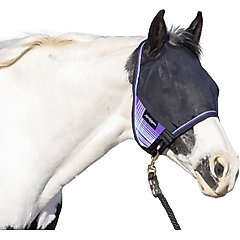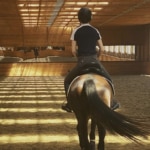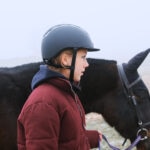10 Fun Facts About Horses

Photo by DianaHirsch/E+ via Getty Images Plus
Riding, caring, and working with horses is highly rewarding, partially because there’s always something new and fascinating to learn.
Riding horses is a lifelong journey, and these amazing animals are full of surprises. Test your knowledge with these 10 fun facts about horses and see if any of them surprised you!
1. Horses Can Sleep Standing Up
While humans must lie down to sleep, horses can sleep standing up or lying down. Horses have a “stay apparatus” in their hind legs that allows them to lock their legs without having to use their muscles to support themselves. The apparatus—a group of tendons and ligaments—holds them up so they can doze while standing.
For a deeper sleep, horses must lie down, and you might occasionally catch them sleeping that way. When living in a herd, at least one horse will usually stay standing up to watch for threats while the other horses lie down to sleep.
2. Horses Can See Almost 360 Degrees
According to Equus, horses have a 350-degree view of the world, compared to a human’s view of about 90 degrees. Since a horse’s eyes are positioned on the sides of their head, they can see almost everything around them without turning their head. Horses can’t see a very narrow area directly in front of and behind them.
That wide field of vision helps protect wild horses from predators, but it also means horses must process a large amount of information. A horse can see tiny changes and objects approaching at a long distance, and they’ll almost always be aware of these changes before humans are.
3. Horses Communicate in Many Ways
Horses use several different types of communication. They use body language to communicate with other herd members, and everything from the twitch of an ear to the position of a horse’s tail can carry a message. Horse sounds like a neigh, nicker, or squeal also convey messages and can provide us with information about how a horse is feeling.
Humans can learn to read horse body language, and we can also communicate with horses using similar body language and positioning. For example, natural horsemanship focuses on communicating with horses using their natural methods, and these gentle techniques can help develop a relationship in which the horse is a willing partner.
4. There Are Over 600 Horse Breeds
Horses come in all shapes and sizes, and hundreds of different horse breeds exist today. Before being domesticated, horses ran wild. Over time, humans caught and trained horses, and then they started to strategically breed them to refine certain desirable traits.
Draft horses were bred to haul artillery during wartime and to work farmland. Lighter carriage breeds were bred to pull carts. Saddle horses were bred to be agile and suitable for riding.
Today, with so many breeds in existence, you can find horses in a wide range of colors and body types suitable for many purposes.
5. Horses Can’t Vomit
Horses basically have a one-way digestive system that prevents them from vomiting. The esophageal sphincter—a muscular valve that seals the stomach’s entrance—is positioned at such an angle that horses can’t regurgitate food or stomach acids.
Since horses can’t vomit, any digestive upset they experience can quickly become serious. Horses experience colic, a severe type of stomachache that can lead to or involve digestive blockages, twisted intestines, and gas.
Many horses need medication like Banamine to control their colic pain and relieve their symptoms, and some need emergency colic surgery.
Recommended Product
6. Horses Use Their Eyes Independently
Horses can use their eyes together in a form of binocular vision, but they can also use their eyes independently in monocular vision.
Essentially, a horse can look at an object using their right eye while also looking behind themselves with their left eye. Each eye delivers information to a different half of the horse’s brain, and those brain halves work independently.
That capability means horses can process large amounts of information, but it also means that the horse’s brain halves don’t always process the same information at the same time.
For example, let’s say a horse sees a frightening object on its left. With a little time, the horse realizes the object is not a threat and calms down. When the horse turns around and the object is on its right, they may spook again. This is because the right eye and corresponding half of the brain still must see, register, and process that object—even though the left eye and half of the brain has already seen it.
7. Horses Can’t Breathe Through Their Mouths
Horses are known as “obligate nasal breathers” meaning they can’t breathe through their mouths, only through their nose. Due to where their palate is in relation to their throat, air passes through their nostrils straight to the throat and into the trachea, the upper respiratory tract, then into their lungs. Horses’ nostrils open up and become larger during strenuous exercise to allow for this extra air intake.
Horses can choke when food becomes lodged in their esophagus, but thanks to their physical makeup, they can continue to breathe while they’re choking because their airway isn’t blocked.
8. Horses’ Teeth Help Tell Their Age
Telling a horse’s age can be tricky, but their teeth provide some helpful information. Veterinarians can examine a horse’s teeth and look at their size, growth, and marks on the teeth to get an approximate idea of how old the horse is.
Horses’ teeth grow throughout their entire lives, and domesticated horses need regular dental work to file down any sharp points and to make sure the teeth align correctly.
9. Horses Often Have Two Names
Many horses have two names. Horses often have a longer, fancy “show” name or registered name consisting of several words. The registered name often includes parts of the horse’s dam’s or sire’s (parents’) names and may hint at their bloodlines.
Those longer names can be a mouthful, so horses also have a more casual, everyday “barn” name, like Lucky or Shadow. Horses can learn to recognize their names, and some will even come when called.
It’s common to find a horse’s “show” name featured on their halter. Nameplates can be attached to the leather cheekpieces to show off those fancy monikers!
Recommended Product
10. Some Horses Need Eye Protection
Some horses need a little extra help protecting their eyes from the sun. Horses with eye conditions like uveitis can be harmed by the sun’s UV rays, so they may wear fly masks with UV protection while they’re outside. Some horses even wear large goggles or visors that help block out UV rays, keeping them comfortable during rides.
Recommended Product
Attributions
This article was medically reviewed by Taryn Holliday, DVM.






